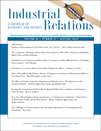This paper examines two central questions related to non‐union employee representation (NER) in Canada and the United States. First, using Taras and Kaufman's (2006) four faces NER approach, we ask whether non‐union and union forms of voice act as substitutes or complements for employees at the workplace? Second, we ask whether non‐union forms of employee representation serve to deflect any latent desire for traditional union voice. We find that NER is negatively related to the presence of unionization at the workplace; it appears to reduce the desire to be unionized. This substitution effect proves to be stronger in Canada than in the United States.
Publication Type
- Article
Journal Name
Industrial Relations A Journal of Economy and Society



